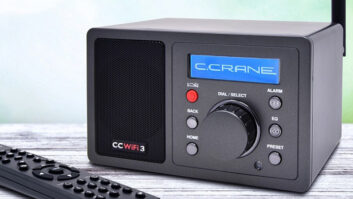Radio Liberty Fans Wonder Whether One of the World’s Great Shortwave Stations Will Really Be Dismantled
A leading Spanish newspaper recently reported that the governments of Spain and the United States had reached a political agreement for the cancellation of the lease contract under which the U.S. government has maintained and operated the facilities of Radio Liberty at Playa de Pals.
The Spanish Senate approved a motion to dismantle the antennas and structures that occupy the 1-1/2 kilometers fronting the Pals beach. The City Council of the town of Pals declared that 90 percent of that terrain would be declared a “green area.”
The fate of the historic facility remains in doubt.
Russian service
For more than 40 years, the Radio Liberty shortwave transmitters at Playa de Pals, on the Costa Brava in Spain, pumped out broadcasts of news and information around the clock to listeners in the former Soviet Union and people of that area who could understand Russian or one of the associated languages. Their targets included most of Central Asia via second hop.
The brainchild of the late Colonel S.Y. McGiffert, chief engineer of Radio Liberty, the site at Playa de Pals, about 75 miles north of Barcelona, was selected in the late 1950s after he and an engineering team investigated many kilometers of beachfront locations in Spain. It was chosen as the best possible spot for banging in a shortwave signal into the Soviet Union.
The colonel demanded a site with ocean in front of it to provide maximum reflection area for the transmitting for the transmitting antennas. He got everything he wanted in the Playa de Pals location.
He also got an 82-acre chunk of land, arguably one of the best pieces of beachside real estate in all of Spain. And thereby hangs a tale. The colonel had powerful connections in Washington that helped him negotiate for the site and eventually obtain a lease on it despite protests of envious development interests that were already aware of the emergence of the Costa Brava as a major tourist mecca.
McGiffert never did things halfway. He hired gilt-edge engineering firms to design the antenna arrays, towers and support structures. Work to lay out roads and build the office/transmitter building started on the site. Installation of four Continental Electronics 250 kW transmitters was begun by engineers from Continental Electronics, assisted by staff technicians. An additional stand-alone 100 kW Telefunken transmitter was installed.
Antenna Groups “A” and “C” were completed first and situated between the antenna switchhouse and the sea. “A” and “C” Group towers were constructed by Brown-Boveri Co. The towers were freestanding, several hundred feet high. Strung between them were the antenna arrays. Made up of cage-type radiating elements, they were backed up by a reflector grid.
In Group A, the two antennas covered the 9, 11, 15 and 17 MHz bands, while in Group C the two antennas covered the same ranges. The configuration consisted of three bays in line, each bay with four stacks. Remote switching permitted using the upper and lower antenna elements or both to achieve vertical “slewing” to change from a low take-off angle to a higher take-off angle.
Vertical “slew” angles were changed in accordance with the ionospheric layer height at the time of transmission. Horizontal “slewing” or steering of the beam from center to 11 degrees either side of center was accomplished remotely by cutting in delay lines.
The design was elegant and state-of-the-art.
Standing tall
When I arrived in Playa de Pals in the fall of 1961, Group B antennas near the entrance were under construction by Spanish firm Miguel Mateu. These were for operation on 6, 7, 11 and 15 MHz. Work on Group D antennas, at the far end of the beach, had not yet started, because the spot for their installation was swampy. It had to be “dewatered,” or pumped more or less dry, for a year before the massive cement foundations for the guy anchor could be poured.
We employees kidded the resident civil engineer, the late “Toby” Taylor, that he was trying to pump the Mediterranean dry.
Eventually, the dewatering work was finished and the pouring of the massive cement bases for the ground anchors was completed. The erection of the steel support towers for the radiating elements and the reflector grid was begun. It took months.
Back at the station, work advanced on the audio control room and internal wiring. Part of the building was devoted to offices and the remainder to the technical installation.
The facilities were great. They included a good restaurant, with meals partially subsidized and affordable. As most employees didn’t have automobiles, busses brought them to the site from centralized pick-up points in nearby Palamos and Palafrugell, where most of the Spanish employees lived.
Eventually work was completed on the Group D support towers, built by CIFA of Milan. And they were tall. The tallest of four guyed towers stood over 540 feet, close to the height of the Washington Monument.
One pair of the guyed towers supported the antenna elements, while the other pair suspended the reflector grid. The structure was designed cleverly so that both the antenna and the reflector were held up by cable, which ran on pulleys.
Whenever the breeze blew – and this was often, at the beach – the front antenna array would tend to belly in. Tied to the ends of the support cables was an elaborate system of counterweights in frames at the base of the towers. The reflectors were equally counterbalanced. In a stiff breeze, both the antenna elements and the reflector grid would belly in, becoming concave. But thanks to the counterweighting, they would maintain their critical separation space and hence keep an excellent standing wave ratio, even during periods of heavy wind.
There were three antennas in this group. D1 operated on 7 MHz; D2 on 9 and 11 MHz; D3 worked on 15 and 17 MHz. D1 consisted of one bay having four stacked horizontal cage dipoles backed by a screen reflector. D2 and D3 consisted of two bays, each having eight stacks of horizontal cage dipoles backed by a screen reflector.
D2 and D3 could be slewed vertically to three positions. Through remote electrical switching, the antenna elements could be combined to provide three vertical take-off angles: a low of 4 degrees, a medium of 8 degrees and a high angle of 12 degrees.
Take-off angles were selected to accommodate any ionospheric height for a specific Russian target. The antenna could be “slewed” or steered laterally plus or minus 12 degrees off center by introducing a delay line between the bays.
What a magnificent antenna. It represented the most sophisticated and versatile antenna design available, which even today has not been improved upon.
Phaseout
In preparing this story, I would be remiss if I didn’t acknowledge the assistance of my colleague Valenti Carbonell, a consulting engineer in Palamos, Spain. Over the years, he filled many engineering positions at the transmitter site. Whenever I’ve forgotten a detail or needed information on the antennas, Valenti, with his encyclopedic knowledge of the antennas, provided an assist.
Over the years there were technical changes at the site. A 250 kW General Electric transmitter was installed. The 100 kW Telefunken was retired and a Marconi 250 kW installed.
The voice-quality program line used to bring in program material from Munich gave way to better program lines and eventually to a satellite system, which delivered programs from the International Broadcast Bureau in Washington.
I left Playa de Pals in 1964 to work at Radio Liberty headquarters in Munich. Thirty-one years later, in the spring of 1995, I was summoned out of retirement to take a job at Playa de Pals to replace the retiring manager. It was to be a short-time assignment as managing director. The facilities and assets of Radio Liberty were being turned over to the IBB, a government umbrella agency, which controlled the Voice of America, Radio Free Europe, Radio Liberty, Radio Free Asia and Radio Marti.
My stay lengthened into six months, during which time a team from Washington came in to cut the staff drastically, terminate bus transportation and subsidized meals. It was a process to cut costs and staff dramatically.
A new IBB manager arrived and took over management duties. The station continued in service until May 25, 2001, when the government terminated operation of Radio Liberty, abruptly stopped broadcasting and sent the staff home.
IBB claimed that their former shortwave listeners were now well-served by local FM and satellite broadcasts and that shortwave transmissions had outlived their usefulness. The station was mothballed, with the specter of dismantling in the offing.
As I write, some changes have taken place. The U.S. Congress has apparently had second thoughts about the cancellation of the lease contract and the dismantlement of the Playa de Pals transmitter site. It has gone back to Radio Nacional, the Spanish government agency that holds the lease, to request that the lease cancellation and the dismantlement be rescinded and that permission be granted to reactivate the transmitter site and use it for broadcasting to the Muslim population, presumably in Central Asia.
Up to now, no decision has been taken to allow that to happen. Meanwhile, powerful Catalan political forces strongly oppose any such cancellation. Having had that beautiful beach property almost within their grasp, they understandably are reluctant to have it slip through their collective fingers. At least one informed source in Spain feels the station is off the air forever. Radio Nacional apparently intends to transfer the real estate to either the national or provincial government, and the Playa operation has lost all of its operating permits, of which there are three (national, provincial and city). The political problems to re-obtain these licenses may be insurmountable.
In the meantime the facility’s fate is in limbo. Those who admire the site, myself included, would hate to see the destruction of such a valuable facility. If the U.S. government is able to make its case and put this site back into operation to continue its war of words, Pals may yet light up its transmitters again and pump its broadcasts to a Muslim population.
The outcome is unclear and bets go either way. As the Spanish might express it, quien sabe? Who knows?







